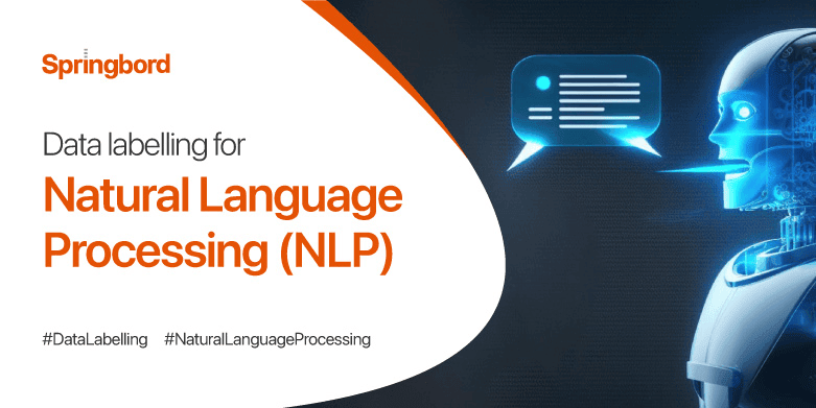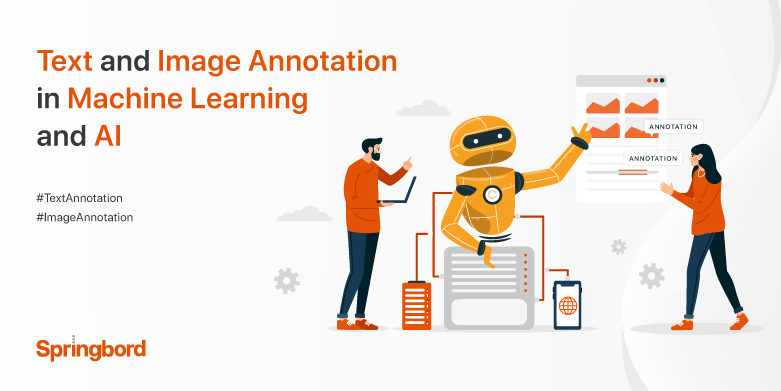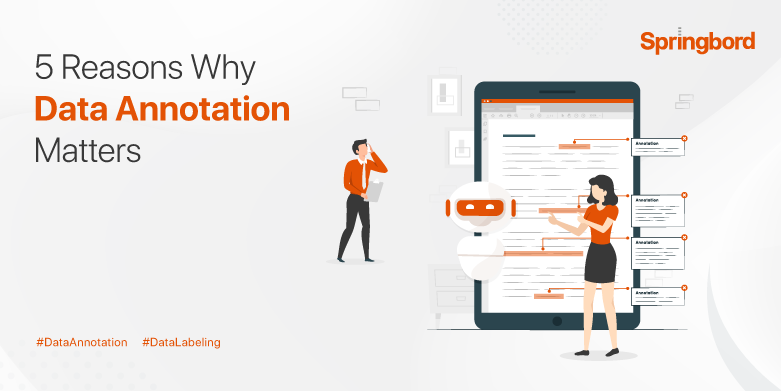 Read time 8 min
Read time 8 minExplore the fascinating realm of data labelling as we uncover the full possibilities of Natural Language Processing (NLP).
In this exciting voyage, we’ll learn how superior labelled data may revolutionize natural language processing tools.
Introduction
Data labelling for natural language processing (NLP) enables machines to comprehend and process human language effectively. To train NLP models correctly, annotating text input with appropriate tags or categories is necessary.
To build trustworthy NLP applications, high-quality labelled data is essential. Here, we will explore data labelling for natural language processing, discussing its importance, the difficulties it poses, and the methods and tools developed to overcome them.
Types of Data Labelling for NLP
Data labelling natural language processing plays a fundamental role in the training and development of language models. Several types of data labelling approaches are utilized to create annotated datasets that facilitate the learning process for NLP algorithms.
A. Supervised, Semi-Supervised, and Unsupervised Approaches:
- Supervised Data Labelling: Supervised data labelling involves manual data annotation, where human annotators assign predefined labels or categories to the text.
The NLP model is compared to these labels during the training phase to ensure accuracy. This method is effective but takes a lot of time and energy, especially for huge datasets.
- Semi-Supervised Data Labelling: Semi-supervised data labelling uses both labelled and unlabeled examples. The model is first trained on a small subset of data that has been manually labelled.
The model predicts labels for the remaining data, and the resulting predictions are added to the labeled data set. Through repeated iterations, the size of the labelled dataset grows, ultimately leading to better model performance.
- Unsupervised Data Labelling:
Third, unsupervised data labelling is a more exploratory method where the algorithm looks for patterns, clusters, or correlations in the text data without providing any labels.
The objective is to unearth latent patterns in the data that will allow the model to self-train. This method comes in handy when it’s difficult or costly to get labelled data.
B. Manual Labelling vs. Automatic Labelling Techniques:
- Manual Labelling: Labels are first assigned by human annotators who read and analyze the text before applying them. This method guarantees high-quality annotations, especially when a human understanding of complicated linguistic nuances is necessary.
However, inter-annotator variability is possible, making the process slow, pricey, and subjective.
- Automatic Labelling Techniques: To automatically assign labels to the text input, automated labelling techniques use machine learning methods, including active learning, distant supervision, and rule-based approaches.
The time and money spent on labelling can be drastically cut with the help of these methods. However, their precision is highly sensitive to the training data’s integrity and the selected algorithms’ strength.
C. Crowd-sourcing and Its Role in Data Labelling:
Crowd-sourcing involves leveraging a large group of individuals, the crowd, to contribute to data labelling tasks. Crowdsourcing is made more accessible by websites like Amazon’s Mechanical Turk and Figure Eight.
This method can swiftly process large datasets because the work is distributed among several people. However, when working with a wide variety of annotators in different locations, it becomes increasingly difficult to maintain labelling uniformity and guarantee high-quality annotations.
Data Labelling Guidelines and Standards
Data labelling guidelines and standards ensure labeled data’s quality, consistency, and fairness in natural language processing (NLP) tasks.
High-quality labelled datasets are crucial for training and assessing NLP models. These can only be achieved with well-designed annotation rules that provide explicit instructions to human annotators and AI algorithms.
A. Designing Annotation Guidelines for NLP Tasks:
- Understand the Task Objectives: Know Your Goals for This Task An effective set of annotation rules can only be created by first defining the NLP task’s unique goals. Knowing the end goal is essential for creating clear and straightforward instructions for annotators, whether for sentiment analysis, named entity recognition, or machine translation.
- Define Labelling Criteria: Clearly define the labels or categories annotators must assign to the text data. The goals of the task and the scope of these labels should be consistent.
Annotators’ ability to understand the complexities of labelling and maintain consistency is improved when examples and edge cases are provided.
- Annotator Training: Teaching the people doing the annotation is crucial. Educate the annotators on the task, the labelling rules, and the difficulties they may face. Annotators’ labelling decisions are more consistent, and there is less room for interpretation thanks to this training.
- Annotation Interface: The efficiency and precision of labelling are highly sensitive to the annotation interface’s design. Annotation is more straightforward and consistent when users can access capabilities like highlighting, tagging, and error reporting.
B. Ensuring Consistency and Quality in Labelled Data:
- Consistency Checks: First, use consistency checks during annotation to monitor how well annotators are doing and ensure they’re following the rules. Consistent labelling is easier to achieve and maintain with constant feedback and clarifying sessions.
- Review and Validation: Annotated data should be reviewed and validated regularly to check for errors and biases. Annotator feedback loops help settle disagreements and fine-tune quality standards.
- Quality Control Measures: Third, use quality control techniques, including data sampling for manual verification, to spot any recurring mistakes or outliers in the tagging. The model’s performance can be continuously improved and fine-tuned by comparing it to the gold standard, labelled data.
- Incremental Annotation: Incremental annotation can gradually release subsets of data with increasing annotations, which is especially useful for large-scale datasets. By cycling through these steps, we can train and validate models early while maintaining high data quality.
- Expert Involvement: Involving domain experts in the data labelling process improves the accuracy and relevance of annotations, especially for specialized NLP jobs. The labelled data will be more in line with the needs of the given domain after being reviewed by experts.
C. Addressing Bias and Ethical Considerations in Data Labelling:
- Bias Identification: The first step in combating bias is to examine the data set for indications of sex, race, and religion-based bias. Determine any discrepancies in how labels are assigned to various groups, and if so, take steps to address the situation.
- Diverse Annotator Pool: Involve a wide range of people in the labelling process from different demographics and cultural backgrounds to reduce the possibility of bias. A more fair and comprehensive data set results from multiple viewpoints being included in it.
- Ethical Guidelines: To stop the spread of prejudice, damaging information, or unpleasant language, it’s essential to follow some ethical rules during the annotation process. To guarantee respectful and responsible annotations, it is crucial to make sure annotators are aware of the ethical implications involved in data labelling.
- Transparent Documentation: Fourth, document everything, from your rules and decisions to any tweaks you made when annotating the data. Audits are made easier with clear documentation, and future problems or issues may be addressed more quickly.
Data Labelling Tools and Technologies
Data labelling is critical to training machine learning models, especially in natural language processing (NLP) tasks. Various data labelling tools and technologies have emerged to streamline the annotation process, enhance efficiency, and improve the accuracy of labelled datasets.
A. Overview of Popular Data Annotation Tools:
- Labelbox: Labelbox is a popular data annotation tool for natural language processing (NLP) jobs and other purposes. It has flexible annotation interfaces, supports numerous annotators, and can handle your data.
- Prodigy: Prodigy is an active-learning-capable, general-purpose data annotation tool. Users can optimize the annotation process by providing timely input to the model and focusing on areas in which it is weak.
- BRAT: Third, BRAT is an open-source program called BRAT (Brat Rapid Annotation program) for text annotation activities. Many natural language processing uses can benefit from its capability for entity annotation, relation annotation, and event annotation.
- Doccano: Doccano is a free and open-source software for annotating texts collaboratively, making it an ideal tool for group assignments. Annotation kinds such as named entity recognition and sentiment analysis are supported.
- Amazon SageMaker Ground Truth: A data labelling solution that uses both human and machine annotation is Amazon SageMaker Ground Truth, our fifth pick. It improves productivity by using machine learning to pre-annotate data and relying on human reviewers to double-check and correct the annotations.
B. Leveraging AI-Assisted Labelling for Efficiency and Accuracy:
- Active Learning: Active learning is a technique that involves selecting the most informative data samples for annotation, reducing the overall annotation effort while maximizing model performance. The labelling process can be sped up with the help of artificial intelligence using a technique called active learning.
- Pre-annotation: Using machine learning models, pre-annotation can automatically identify parts of the data before humans review it. As a result of this preliminary labelling, the burden of human annotators can be greatly reduced, resulting in increased efficiency without any loss of accuracy.
- Weak Supervision: Weak supervision techniques leverage heuristics, rule-based models, or distant supervision to assign noisy labels to data. These low-quality labels are used as a springboard for further training that can be improved using human comments.
- Transfer Learning: We have transfer learning, which allows refining previously learned models for use in new natural language processing applications. When labelled data are scarce, AI-assisted labelling can improve accuracy and efficiency by drawing on the lessons learned by previously trained models.
Evaluating Labelled Data and Model Performance
Evaluating labelled data and model performance is a critical step in developing and deploying natural language processing (NLP) models.
This process involves assessing the quality of labelled datasets and measuring the effectiveness of NLP models in achieving the desired task objectives.
- Evaluating Labelled Data:
- Data Quality Assessment: Before training an NLP model, it is crucial to evaluate the accuracy of the labelled data. a. Inconsistencies, mistakes, and biases in the annotations must be found and fixed.
Methods such as measuring inter-annotator agreement (IAA) can be used to evaluate the consistency and accuracy of a labelled dataset by having many annotators independently label a subset of the data.
- Label Distribution: Insights into possible class imbalances can be gained by analyzing the label distribution in the dataset. Misguided model predictions can result from class imbalance, which occurs when some labels are overrepresented or underrepresented. Eliminating inequalities across classes is essential for a well-functioning scheme.
- Data Preprocessing: Tokenizing, stemming, and normalizing are all examples of data preprocessing operations crucial to natural language processing (NLP). Since preprocessing might affect model performance, assessing how various preprocessing strategies affect the labelled data is necessary.
B. Evaluating Model Performance:
- Metrics Selection: Picking the right measures to evaluate model performance is essential. Accuracy, precision, recall, F1 score, and area under the receiver operating characteristic curve (AUC-ROC) are often used metrics for natural language processing tasks.
Metrics should be selected in light of the nature of the task at hand and the tradeoffs you hope to achieve.
- Cross-Validation: The generalization performance of a model can be estimated through cross-validation by splitting the labelled data into numerous subgroups for training and testing. This method aids in detecting overfitting and guarantees the model’s stability on new data.
- Test Set Evaluation: The final model’s effectiveness is judged compared to a test set that was not used in the development process. This guarantees a fair assessment of the model’s adaptability to novel inputs.
To Sum Up
Data labelling plays a crucial role in enabling the development of accurate and effective natural language processing (NLP) models.
Developing strong data labelling norms and standards is crucial since the quality of labelled data substantially affects the performance of NLP applications.
Springbord is dedicated to offering high-quality, industry-specific data gathering and processing solutions because we value accuracy and know its importance to your business.
To ensure the best-labeled data for NLP applications, we provide full business process outsourcing services to clients in the private and public sectors by utilizing state-of-the-art Internet-based skills and resources.







